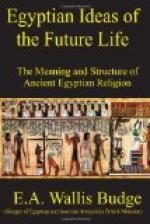The gods of Egypt whose names are known to us do not represent all those that have been conceived by the Egyptian imagination, for with them as with much else, the law of the survival of the fittest holds good. Of the gods of the prehistoric man we know nothing, but it is more than probable that some of the gods who were worshipped in dynastic times represent, in a modified form, the deities of the savage, or semi-savage, Egyptian that held their influence on his mind the longest. A typical example of such a god will suffice, namely Thoth, whose original emblem was the dog-headed ape. In very early times great respect was paid to this animal on account of his sagacity, intelligence, and cunning; and the simple-minded Egyptian, when he heard him chattering just before the sunrise and sunset, assumed that he was in some way holding converse or was intimately connected with the sun. This idea clung to his mind, and we find in dynastic times, in the vignette representing the rising sun, that the apes, who are said to be the transformed openers of the portals of heaven, form a veritable company of the gods, and at the same time one of the most striking features of the scene. Thus an idea which came into being in the most remote times passed on from generation to generation until it became crystallized in the best copies of the Book of the Dead, at a period when Egypt was at its zenith of power and glory. The peculiar species of the dog-headed ape which is represented in statues and on papyri is famous for its cunning, and it was the words which it supplied to Thoth, who in turn transmitted them to Osiris, that enabled Osiris to be “true of voice,” or triumphant, over his enemies. It is probably in this capacity, i.e., as the friend of the dead, that the dog-headed ape appears seated upon the top of the standard of the Balance in which the heart of the deceased is being weighed against the feather symbolic of Ma[=a]t; for the commonest titles of the god are “lord of divine books,” “lord of divine words,” i.e., the




